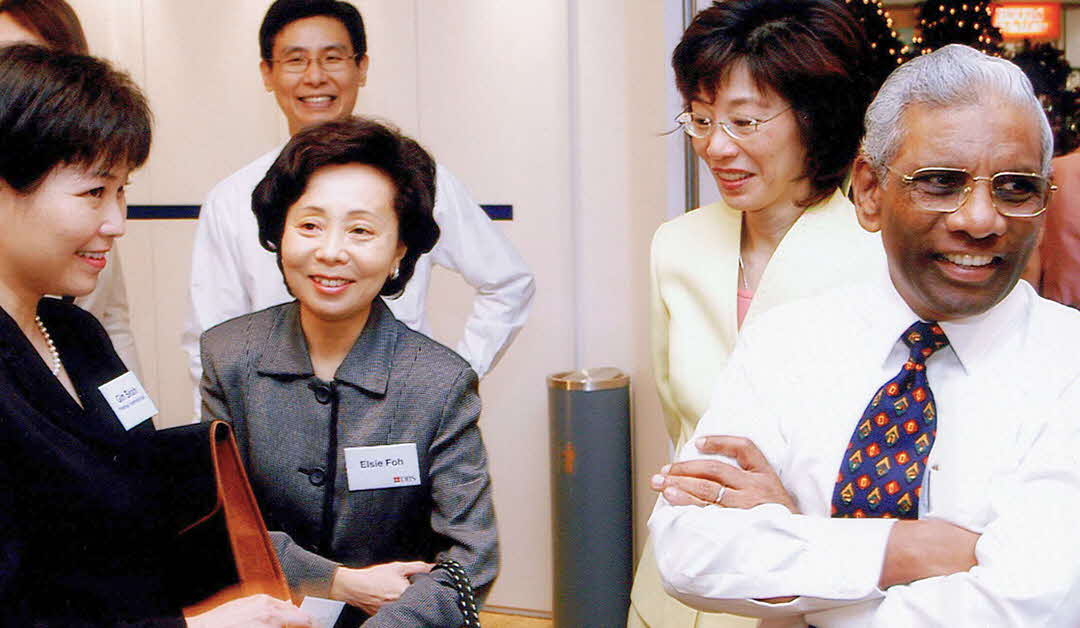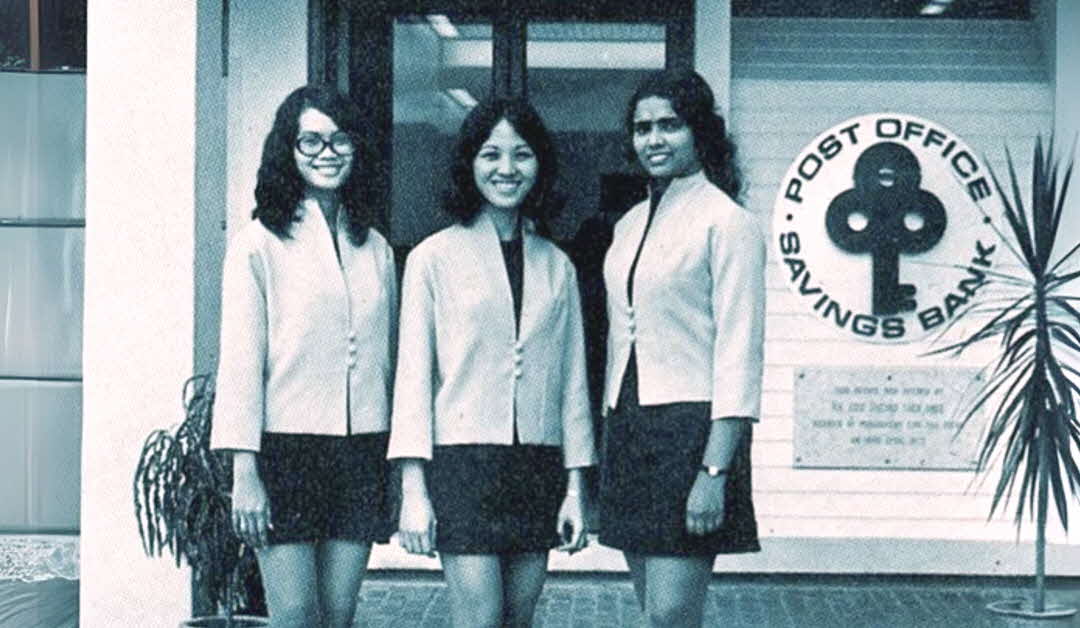neighbours-first-bankers-second
Neighbours First, Bankers SecondNeighbours first, bankers second: The POSB story
By DBS and The Nutgraf, 7 Feb 2025

Ms Elsie Foh (2nd from the left) pictured alongside Ms Lam Siok Loon, then Head of POSB, and Mr S Dhanabalan, then Chairman of DBS, at the opening of a POSB branch in Hougang in 2003. Photo: DBS
The articles in this series are presented jointly by DBS and content agency The Nutgraf. The Nutgraf team interviewed alumni and employees to uncover these lesser-known stories about the bank, and its key contributions to Singapore.
In 1997, DBS veteran Elsie Foh was roped in to work on a top-secret project, which would later be described by the media as “a momentous step in Singapore’s banking history”.
“It was a very confidential transaction,” recalled Ms Foh, who was then Executive Vice President of DBS Retail Banking. “We had to think very carefully about how to prepare the ground before the big announcement happened.”
On 24 July 1998, then-Finance Minister Richard Hu delivered the big news: DBS and POSB – which was then known as POSBank – would merge in an SGD 1.6 billion deal. This was “in line with the Government’s policy of encouraging local banks to…consolidate their operations and develop into sizeable banks to compete internationally,” he explained.
The union would cement DBS’ position as the largest bank in Singapore and Southeast Asia, while helping POSB – dubbed “the man-in-the-street’s bank” – to better serve increasingly sophisticated customers.
The match had strong merits. Still, the merger had to be weighed meticulously for months before it was finalised and made public. After all, it concerned the future of Singapore’s oldest bank, which was loved by Singaporeans from all walks of life, from the low-income to seniors, children, and National Servicemen.
“POSB is the People’s Bank,” said Ms Foh. “It had a different culture from DBS. So, before the merger, we had to strategise and consider questions such as: How would POSB be changed? What would we do with the POSB brand? How can we prevent attrition of POSB staff?”
Ms Nora Kang, a veteran “POSB girl” who in 1998 served as General Secretary of the POSB Staff Union, had similar questions when she heard news of the merger.
“I was very worried: What would happen to the staff under my care, and all the years of rapport built with our customers?” she recalled. “Thankfully, the decision was made for POSB to keep its brand name and mission to be a people’s bank.”
Change to survive
Following the merger, POSB would embark on a journey of rejuvenation that has kept it fresh, relevant, and unique to Singapore to this day – even as DBS grows its reach and brand as a leading pan-Asian bank.
Staff from both groups were retained – and many retrained to take on new roles, as the combined entity grew its assets, which stood at about USD 93 billion in 1998, by more than five times to become the world’s 63rd largest bank in 20231. Its return on equity (ROE) also soared from 10.35% in 1999 to 18% in 2023 – the seventh highest among all banks globally.
But back in 1998, it was less clear how the decision to preserve this iconic brand, while integrating it into the DBS group, would pan out.
Barely a year after the merger, POSB started to face an onslaught of red-hot competition from local and foreign banks for market share, as Singapore opened up its financial sector.
The liberalisation measures “transformed consumer expectations about the speed, efficiency, and quality, of services”, recalled Ms Susan Cheong, a DBS veteran who joined the bank in 1998 and headed POSB from 2016 to 2019.
POSB’s pivot from a statutory board to full commercial operations with a competitive edge was not a walk in the park.
DBS Chairman S Dhanabalan indicated as much in a media interview a few days after the merger, where he shared how banking had evolved so fundamentally that POSB would have to be restructured to offer new services – or lose its customers.
"People's awareness of banking, the types of products they want, the awareness of sensitivity to interest rates as well as cost of transactions, these are all far greater today than they were 50, 40, or even 10 years ago," he pointed out.
“POSB couldn't continue to operate the way it was," he continued. "So, the question is not: Why not leave it alone? If you left it alone, it would die a natural death. It had to change and the POSB management knew it."
Reaffirming the POSB brand promise
With DBS by its side, POSB set out to rejuvenate customer service, revitalise its brand offerings, refresh its iconic products, and reshape inclusive communities – all the while guided by its motto of “Neighbours first, bankers second”.

Mr Jeremy Soo with a delighted recipient of a POSB coin bank in the 2000s. Photo: DBS
“It was a privilege for DBS to merge with POSB, which – by virtue of its very broad customer base – represents our country,” said Mr Jeremy Soo, head of DBS Singapore’s Consumer Banking Group. “The leadership recognised that we need to hold up and protect the POSB brand, to ensure that it will not be lost for future generations.”
POSB’s origins as a neighbourhood bank can be traced back to 1877, when it was set up by the British colonial government’s post office department to provide banking services to the poor.
In 1968, POSB was directed to promote domestic savings by the newly independent Singapore government. The next year, the number of new accounts shot up by a staggering 652%.
By the 1970s, virtually every Singaporean had his or her salary credited into an account with POSB, which had built up the country’s largest ATM and branch network.
POSB was also a bank for shared national memories. “So many of us Singaporeans, from government ministers to workers, remember the hugely popular National School Savings Campaign from our childhoods. It encouraged students to collect stamps for their very first savings accounts,” recalled Mr Soo.
And Singaporeans of all ages – from the Pioneer and baby boomer generations to some millennials – still wax nostalgic about their little brown or blue passbooks.
All this puts the bank in a unique position in today’s highly competitive retail banking market. “At any one time, POSB is banking up to three generations of Singaporeans,” said Mr Soo.
These three generations of customers are: the passbook users; ATM users, and mobile app users. Over time, DBS has transformed its entire backend and front-end network to provide 24/7 accessibility for all these users to its banking services, while ensuring that POSB customers of all generations continue to find its banking services highly relevant to their needs, Mr Soo said.
This effort has paid off: nearly 70% of POSB customers who opened passbook accounts as kids still hold on to them – and to POSB’s neighbourly brand promise.
Renewing POSB’s service tradition
With this multi-generational customer base in mind, it was clear to POSB that the more it changed to keep pace with Singapore’s fast-liberalising financial sector, the more it would need to renew and amplify its neighbourly touch.

The first generation of POSB Girl – specially trained bank tellers – in 1972. Photo: DBS
Enshrined in Singaporean’s collective memory is the warm service of “POSB Girl” bank tellers. These POSB staff were known to read out documents to illiterate customers and go the extra mile to help sick or elderly customers complete their transactions in their homes.
It is a neighbourly service that POSB continues to offer today, said Mr Soo. “We call it bedside banking. We go to the hospital to help our elderly customers.”
As DBS and POSB transformed digitally to support Singapore’s development as a Smart Nation, the group has also taken pains to ensure that seniors are not left behind in a cashless society.
“Customers today can access their passbooks through digital means, and they enjoy a seamless journey when accessing their DBS and POSB accounts because we integrated the backend systems and centralised book-keeping,” said Mr Soo. “But there are customers who still want to update their passbooks at our branches, and we take care of them.”
During the COVID-19 pandemic, as DBS accelerated the digitalisation of its customer interactions through virtual branches, it was careful to retain physical elements in branches such as tellers and ATMs that accept passbooks to help older folks feel at ease.
“If our elderly customers cannot see the physical elements they’re familiar with, they won’t know what to do. So we chose not to move to a completely automated environment even though that may be more efficient,” said Mr Soo.
“POSB is run as a commercial bank. But our key priority is till to fulfil our role in the community.”
Redesigning the customer journey
While today’s POSB branches retain key physical fixtures to provide reassuring familiarity for elderly customers, their overall layout and look have evolved over time to provide more efficient, seamless customer service, said Mr Tan Wee Jen, who has renovated POSB and DBS branches for over four decades.
Today, POSB and DBS branches sport a reinvented layout that have vastly enhanced their pre-merger functions, explained Mr Tan, who still enhances DBS’ workspaces in his current role as a key member of its Corporate Real Estate team.
In the early days, POSB thoughtfully designed branch features such as an open hall with a reception counter to facilitate queuing, and rows of seats for customers to wait for their turn. There was even a children’s corner at the White Sands branch to keep kids occupied while their parents were doing transactions.
“People trusted us so much that they used to leave their kids at a POSB branch in the heartland branches like Ang Mo Kio or Bedok while they went marketing. It was like a daycare,” he chuckled.
To sweeten the extra-long wait times during Chinese New Year, POSB branches would extend their opening hours and give out candy to customers lining up to exchange cash for brand new notes fit for red packets, recalled Mrs Lam Siok Loon, who headed POSB from 2002 to 2004.
But with crowded branches and long lines increasingly becoming a bugbear for time-starved customers, POSB needed to optimise its branch layouts to boost convenience and efficiency of its banking services.
One of the most memorable makeovers that Mr Tan helmed was in 2006, when POSB did away with an old multi-coloured, multi-zone design, and made every branch uniform in layout and colour scheme.
This helped to boost staff productivity. “When staff from a Yishun branch, for example, are posted to a Toa Payoh one, they would never feel lost,” he said. “They know exactly where the full set of equipment is located – right behind them at their stations so that they can work fast.”
Another outcome of the redesign was slashed wait times: the reception counter was removed to avoid crowding, while floor managers walked around the open hall to direct customers with simple requests or non-cash transactions to “quick service” pods.
Over time, queues would get even shorter, as POSB branches adopted more technology features, from SMS queue numbers to online banking access and Video Teller Machines (VTMs).
Revitalising POSB brand offerings
POSB’s branch redesign – marked by the bold blue, bright white, and gold hues in its revamped logo – also reflected its rejuvenated brand image.
“POSB’s branch environment became brighter and livelier, to look more appealing to retail banking customers,” said Mr Tan.
POSB’s refreshed brand image was backed by a slew of innovative products to woo the mass market.
As a statutory board back in the day, POSB had tapped its huge savings base to provide highly affordable housing loans. It launched the market’s first-ever HDB home ownership scheme in 1974 with 20-year home loans that offered reasonable rates and easy repayment terms.
This was a milestone that it would repeat in 2013 with a new POSB HDB home loan. The first-of-its-kind floating rate package for HDB homebuyers offered interest rates lower than or capped at the Central Provident Fund rate of 2.5% annually for the first decade – estimated to help families save about SGD 200 a month at that time -- with no pre-payment penalties.

Mr Derrick Goh handing out mandarin oranges to customers during his visit in 2014 as part of the bank’s Lunar New Year celebration. Photo: DBS
“It was a massive hit,” recalled Mr Derrick Goh, who headed POSB from 2012 to 2016. “We loaned about SGD1.6 billion to almost 6,500 families.”
Another groundbreaking product was the PAssion POSB Debit Card, also launched in 2013. This was the first time a bank had tied up with the People’s Association (PA) to launch a community debit card with TransitLink’s EZ-Link functionalities, rewards at retail outlets, and no income requirements.
“We saw strong synergies between POSB’s ATM cardholders and PA’s membership base. To cater to this group, we created a card that was intuitive and easy to use – and now we have more than 2 million card holders,” said Mr Goh.
Refreshing formats to boost financial literacy
To bolster its growing range of innovative solutions, POSB rolled out initiatives for Singaporeans of all ages to rediscover its iconic offerings in refreshed, phygital – a combination of physical and digital – formats.
“We want POSB to be perceived by younger generations of Singaporeans not as my father’s or grandfather’s bank, but as my bank,” said Mr Soo.
Equally important was POSB’s heart for inculcating a savings culture in the younger generation. That was why POSB brought back the iconic National School Savings Campaign (NSSC) – which was first launched in 1969 – in 2015.
By 1971, the NSSC had reached peak participation of 100% in primary schools. This feat would be repeated when POSB brought back the campaign in 2015, as a new generation of kids embraced Smiley the Squirrel and the lessons of saving for a rainy day that the much-loved mascot embodied.
The campaign, in commemoration of Singapore’s 50th birthday, allowed the kids to engage with their parents and share the same values of thrift that the latter had learned during their own NSSC experiences.
“The programme provided the perfect platform for me to bond with and inculcate good saving habits in my son,” said Mr Joshua Lee, whose son eagerly collected stamps to fill up his savings card during the 2015 campaign.
“I noticed he has started to display enthusiasm and effort in thinking before spending – something which has never happened before.”
Two years later, POSB built an enhanced stamp savings programme featuring Smart Buddy, the world’s first in-school savings and payments wearable. This phygital approach proved a game-changer in financial education: Armed with this nifty physical gadget, students learned to save and spend wisely by digitally tracking their savings and spending habits.
Smart Buddy could well become the next POSB icon for future generations of Singaporeans to reminisce about. But for now, it has certainly sowed seeds of financial prudence in this latest batch of young Singaporeans to join the POSB community.
Reshaping inclusive communities
At POSB, banking access and financial literacy outreach extend across all age groups and backgrounds.
“POSB was seen as always having a heart for the community, always seeking to help Singaporeans protect their nest egg,” said Mr Goh.
With more banking transactions automated or moved online, more private rooms were set up in branches. Here, POSB relationship managers could advise customers on prudent money management and customise financial solutions such as insurance and investment for their specific needs.
POSB also expanded its channels for financial education, from seminars in community centres to finance fairs at polytechnic campuses to skits in primary schools.
And with cyber scams increasingly common, DBS has teamed up with grassroots organisations like PA and agencies like the Infocomm Media Development Authority to boost customers’ digital literacy and awareness against online fraud.
Another group that POSB reached out to were work permit holders. During the COVID-19 pandemic, it was the only bank with the infrastructure capable of helping migrant workers – who were among the hardest hit by the virus outbreak and safe distancing measures – open bank accounts, so that they could continue to get their salaries and conduct transactions.
It was a complex challenge, acknowledged Mr Soo. “But we had to do it – and do it efficiently – because migrant workers are an integral part of our workforce,” he said. “Our call to duty and inclusivity supersedes profit motives.”
A national heirloom
Even as POSB continues to evolve, it is sticking to its calling to be neighbourly first – and always.
The brand’s unique heritage is not owned just by DBS, but by the whole nation, said Mr Soo
“Future leaders of DBS will have the same privilege and important duty as we have to protect this brand for generations of Singaporeans to come.”
1The world’s largest banks by assets, 2024 | S&P Global Market Intelligence (spglobal.com)

